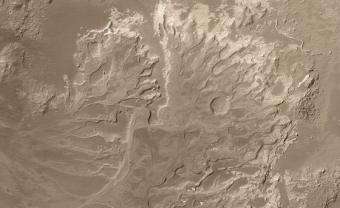Early Mars Environment

University of Arkansas researcher studying the thermodynamics of the oldest present-day clays on Mars found a surprising result in his calculations. Although evidence suggests that liquid water once flowed on the planet's surface, the most common greenhouse gas that could have warmed the atmosphere enough for liquid water to exist appears to have been scarce.
Vincent Chevrier, a researcher in the Arkansas Center for Space and Planetary Sciences, reported his findings at a recent Lunar and Planetary Sciences meeting.
Chevrier based his thermodynamic calculations on the current composition of clay minerals in outcrops from the Noachian age, some of the oldest formations found on Mars at about 4.5-4 billion years old. Evidence points to a role for liquid water in the formation of these clays: clay minerals form on Earth through weathering processes that involve liquid water, and the presence of what look like river channels and ice caps on Mars suggest that at one time, liquid water existed on the planet's surface.
Chevrier used thermodynamic calculations to look at the equilibrium between silicates and clays in the formations to extrapolate the historic conditions that shaped the outcrops. He included information on the current composition of the rocks, the current atmospheric conditions and the possible historic presence of liquid water in his calculations.
To maintain liquid water on the planet over enough time to form clays, the atmosphere must have contained sufficient amounts of a "greenhouse gas," the most likely candidate being carbon dioxide. However, Chevrier's calculations suggest that atmospheric carbon dioxide wasn't abundant enough to sustain liquid water, and at a greater abundance than his calculations suggest, the gas would have formed a different sort of mineral - carbonate - in addition to the clays. However, no carbonates have been found on Mars.
"That was a big surprise," said Chevrier. "Right now, we don't have an answer to this."
It is possible that, if atmospheric carbon dioxide was abundant enough to form carbonates, the carbonates might have been destroyed by a more acidic environment, which did exist later in the history of the planet. It also is possible that carbon dioxide never existed in high abundance in the early atmosphere of Mars and that another greenhouse gas was responsible for liquid water formation. However, other possibilities include sulfur dioxide, which leaves no traces of existence until later in the history of Mars, or methane, which does not react to form minerals. A third possibility suggests there is some other missing factor that might have helped maintain a sufficient pressure and temperature for the clays to form, Chevrier said.
"Thermodynamics can take you from point 'A' to point 'B', but it doesn't explain how you got there, or at what time scale," Chevrier said. The next step would be to figure out the mechanisms that existed to create modern-day Mars.
The Arkansas Center for Space and Planetary Sciences is part of both the J. William Fulbright College of Arts and Sciences and the College of Engineering.
Source: University of Arkansas

















